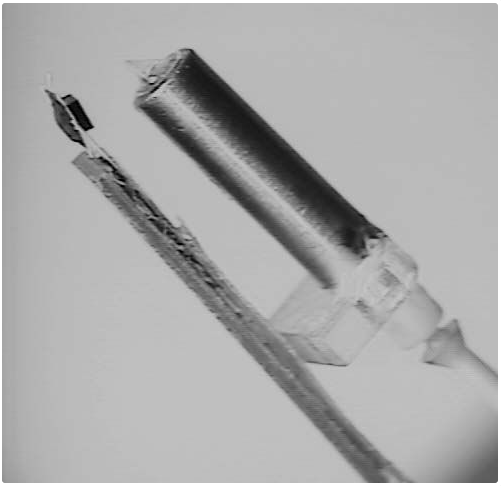Over ninety percent of all human cancers arise in epithelial tissues. Several imaging techniques including MRI, ultrasound and optical coherence tomography (OCT) and elastography are used to detect cancers. However, the resolution of MRI and ultrasound is too low for the imaging of epithelial tissues. When compared with MRI and ultrasound, OCT has much higher resolution, 10μm or less. The higher resolution is advantageous in cancer detection of epithelial tissues that are accessible using an endoscope.
The scan angle of an OCT scanning mirror is critical to its imaging capability. The Amplified Bimorph Scanning Mirror and the OCT scanning system developed at the George Washington University include a large-angle OCT scanning mirror and an optical system. The advantages of the Amplified Bimorph Scanning Mirror and the OCT scanning system include the ability to scan an OCT imaging beam at real time imaging speeds and to produce much larger scan ranges than the existing OCT imaging technologies. These two capabilities have the potential to allow us to effectively search the tissues for cancer rather than just taking data at selected locations in a manner similar to conventional tissue biopsies. This scanning mirror can be also be used for non-biomedical purposes, such as to detect defective products or bar code scanning.
Currently available noncircumferential scanning mirror probes have scan angles only up to 40 degrees with imaging rates of 8 frame per second or less. The Amplified Bimorph Scanning Mirror and the OCT scanning system can produce large lateral scan ranges at real-time imaging speeds. Due to the specially designed microelectromechanical (MEMS) structure, the Amplified Bimorph Scanning Mirror-based OCT scanning system has demonstrated optical scan angles between 40 and 97 degrees at resonant frequencies between 15 and 60 Hz; and it can be operated at temperatures from 70 to 95 °F degrees with no loss in performance. These characteristics make the Amplified Bimorph Scanning Mirror appropriate for real time imaging and in vivo image scanning. The Amplified Bimorph Scanning Mirror and its support structures have been fabricated in two sizes; for small devices 1.125 mm wide tablets and larger devices with 2.25mm wide tablets.
Prototypes of the Amplified Bimorph Scanning Mirror have been made and integrated into a high-speed spectral domain optical coherence tomography (SD-OCT). This scanning mirror and system are able to produce images at the rate of 25 to 41 frames per second. The scanning mirror can be easily integrated to into all types of SD-OCT imaging systems and have the potential to expand the clinical utility of endoscopic OCT by producing real-time images that will better enable detection of tissue abnormalities and improve guidance in interventional procedures.
The Amplified Bimorph Scanning Mirror can also be used in combination with Acoustic Radiation Force Imaging Probe. The combined techniques will provide information regarding both the optical and mechanical properties of tissues being interrogated. This information can then be used to detect cancers early, improving patient outcomes.

Fig. 1 - Amplified Bimorph Scanning Mirror for Optical Coherence Tomography
Applications:
- Medical Imaging: Amplified Bimorph Scanning Mirror will improve the scanning angle of current OCT devices;
- Industrial Imaging: Non Destructive Testing(NDT) and material thickness measurements, etc.
Advantages:
- The Amplified Bimorph Scanning Mirror has a much larger scan angle of 40 to 97 degrees in a sector scan format compared to previously reported 40 degrees.